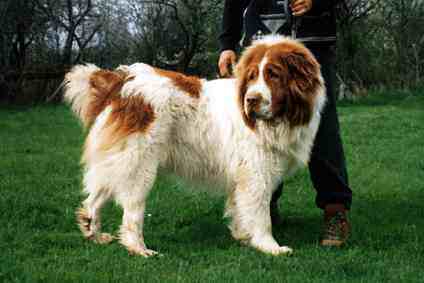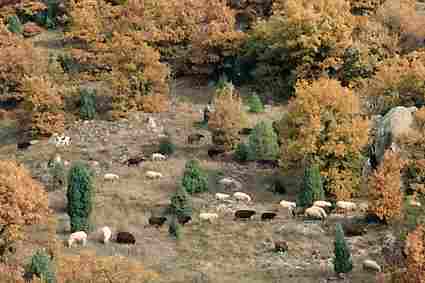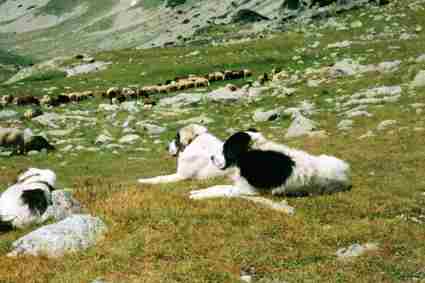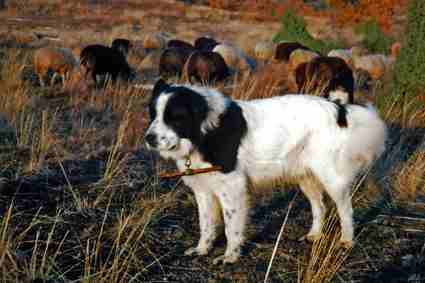|
|
|
|||
|
The
Karakachan Dog - Continuation of an old Bulgarian Tradition Introduction |
||||
|
Fig. 1: Karakachan Dog. (Photo: Atila Sedefchev) |
||||
|
I can not explain the exact reason, but these dogs impressed me a lot during my childhood. Working beside my grandfathers who had sheep I had the possibility to have direct contact with these dogs in their natural environment. 13 years ago my brother and I started to seriously work on this breed and started breeding such dogs. Searching for the last dogs left with the flocks and finding all the information that existed about the breed turned into a kind of mania for us. The hundreds of expeditions and meetings with shepherds and their dogs are the base on which we build up our knowledge of the working Karakachan Dog. A lot of dogs passed through our hands. We purchased them from shepherds. They are the base of the breeding work in our breeding station. Not all these original dogs are live anymore, but they gave us the possibility to breed many of their descendants. In 1997, with other colleagues, we registered the Bulgarian Biodiversity Preservation Society - SEMPERVIVA, which main part of work is dedicated to saving rare native breeds of domestic animals. Within the framework of this activity, society established and own flocks of rare sheep and goat breeds guarded by Karakachan Dog. In 1997, together with the BALKANI Wildlife Society and particularly with their Wolf Conservation team, we started a project to support herdsmen with Karakachan Dog to help protect their flocks. The main goal of this activity is to reduce the conflict between local people and large carnivores. Another important aim for us was to return and maintain working Karakachan Dog populations. During the first project phases, we worked in areas where livestock losses are mainly caused by wolves. In that period the work was financially supported mainly by EURONATUR, but also by the Wolf Protection Society (GzSW) and the Wolf Conservation Trust (UK). Since 2002 the same activity is being continued with the financial support of the ALERTIS Foundation, formerly the International Bear Foundation, and the work is done in regions, where bear attacks on livestock occur. This is done in order to decrease the human - bear conflict and as a consequence improve the conservation of the wild bear populations. |
|
|||
|
Study area In
Bulgaria livestock grazing is traditionally extensive and such dogs
have been used for millennia. Large carnivores such as wolf, brown
bear and lynx Lynx lynx have always been present in Bulgaria. The
numbers and the densities of the wolf and the brown bear are among
the highest in Europe. On a territory of about 20,000-25,000 km2,
which is suitable for large carnivores, there are about 1,200 wolves
and 600 bears (Tsingarska 2005). The golden jackal has become a
very numerous predator too, particularly during the last 20 years,
when it spread across the country. The type of terrain in this country
is mountainous and forested. Usually flocks are grazed in such rough
areas which makes the dog's work complicated (Fig. 2 & 3). In
summer some of the flocks are moved up to the alpine pastures for
3-4 months (Fig.4).. |
||||
|
Fig. 2 & 3:
Flocks guarded with Karakachan Dogs on typical grazing areas.
Fig. 4: On the
summer alpine pastures (up to 2500m.) in the Pirin mountain. |
||||
|
Project
There are several main principles in the work
on this project. We very carefully choose the herdsmen, who will
be provided with dogs. We never had the idea to give dogs in large
numbers. According to our opinion it is better to select livestock
owners, who will not only use the dogs but who will also continue
this process by producing puppies and giving them to other owners.
In this way, the effect of the natural dispersion of these dogs
is achieved. That is the reason we always give a male and a female
puppy at 2-3 month's age which are not related to each other and
which can potentially breed together. Thus, the owners make minimum
efforts for breeding the dogs and in the same time the selection
of the breeding pair is made by us. In some cases we give more than
two dogs to an owner. This happens when we consider it is necessary,
because of large number of livestock, difficult terrain for the
dogs and suitable for predator attacks, or high carnivore density.
Another important factor when selecting a dog owner is the effect
which will be achieved by the work of the dogs guarding the flock.
For instance, if the animals in the flock are gathered together
from several owners, the effect of this activity will be bigger.
We hope that if people have less problems with predators, that there
will be less reason to poach bears or wolves. Often we choose common
flocks, in which the livestock is gathered together from all the
people in the village. In one flock, numbering 1,200 animals, where
sheep were gathered from 114 different owners, we gave four dogs.
Later the shepherd of this flock produced many puppies and kept
4 of them for himself. |
||||
|
Effectiveness of the Karakachan Dog The
effectiveness of the dog's work is very high. Since 1998 there have
been altogether three cases of successful predator attacks in the
flocks provided with dogs in the frames of this project. In one
big flock of 650 sheep, four had been killed. Actually, the mistake
in that case has been done by the shepherds who had divided the
flock in two parts during grazing and one of the two parts had been
left without dogs. Our
own project flock is protected by five Karakachan Dogs. The two
males MURCHO and PERUN, work very well together. It is typical for
PERUN that he always moves behind the last sheep and if he does
not come back with the flock it means that some sheep had dropped
behind and he is there. In the evening when the flock is resting
he takes the position from where most potential attacks occur. On
the other hand MURCHO moves in front of the animals and when the
flock turns in a different direction he literally searches the area.
This behavior is innate and I have observed it with other dogs.
The other three dogs in our flock make the team really effective.
For four years there were many attacks on the flock, but none of
them were successful. All these years we had the possibility to
observe the dogs reaction against wolf and bear attacks. They register
the presence of a predator in time and chase it sometimes up to
two kilometers. We have seen that if a wolf stops for a moment to
scare them, the dogs go in directly, fighting with a clear intention
to kill the wolf. However, it is very unusual that dogs manage to
catch or kill a wolf. Usually the wolves outrun them. In the cases
when this happens most often these are young wolves around 1 year
old. Some people may consider that this behavior is worse than the
accepted opinion that the dogs should always keep close to the flock.
However, when I saw a film made with thermo-sensitive camera in
the French Alps I saw how the Great Pyrenees chased the wolf only
short distances before leaving it. Even if the predator stops, the
dogs also stop, and start barking at it. It is visible that this
doesn't scare the wolf. Just the opposite, the dogs show him with
their behavior that they are not a real obstacle and the wolf's
success is just a question of time. And this was exactly the result
in the documentary. When the dogs chase the wolf with the intention
to kill it, this means much more for the wolf. In Bulgaria the theory:
"The dog barks - the wolf runs away" is not valid. If
it was like this there wouldn't have been cases of dogs killed by
wolves and more seldom the opposite. Probably the reason is that
both the dogs and the predators are experienced with one another.
The wolf can see if the dog is not determined enough and would make
attempts to attack if it is not seriously disturbed. On the other
hand dogs see that they should clearly show that intruders can get
in troubles. |
||||
|
Problems One
of the most common problems we encountered was poor feeding of the
dogs while growing up. This was against the contract clauses. But
on the other hand shepherds are among the poorest people in Bulgaria.
Eventually, the owners themselves loose from the result, because
their dogs do not develop well. Certainly, sometimes other contract
clauses are not respected, but this did not disturb the main process.
Until now, there has been only one case where we had to take back
two dogs. |
||||
|
Fig. 5. Karakachan Dog wearing
a stick which acts as a hindrance to prevent the dog from running.
|
||||
|
The
real reason for the hunter's hatred of livestock guarding dogs is
the fact that they sometimes kill hunting dogs, which try to penetrate
into a flock. Hunting dogs are often left outside alone after the
hunting day ends and they chase wildlife. Unfortunately there is
no regulation which controls this free hunting dog movement in the
forest. Another problem we met is that two of the given dogs were
stolen. Unfortunately, we can't control and prevent such cases.
Thus, until now there haven't been problems with the given dogs.
The main problem is the human factor. A main topic in our work is the selection of dogs from which we would get offspring to be distributed later. The criteria of a good working LGD in Bulgaria - and my personal criteria - differs from the criteria of some colleagues from western countries. The
socialization process is accepted as a key factor for the future
dog's development and work. In many publications concerning LGD
behavior, the same methods are described for proper socialization
of a puppy (Mazover 1956, Coppinger et al. 1988, Green & Woodruff
1990, Landry 1999, Coppinger & Coppinger 2001; Dawydiak &
Sims 2004). As a very important factor, the right age to introduce
the dog in the flock is pointed out and a feature of successful
socialization is a submissive position towards livestock. Certainly,
I would not like to underestimate the role of the socialization,
however there are other crucial and important factors for the dog's
protective effectiveness. Quite often there is the statement that the dog should create a feeling of being one of the sheep. I think this is not possible and I can't understand why so much attention is paid on this as a factor of good guarding behavior. According to my opinion based on my practice the dog realizes very well that it is required to protect livestock. At the same time the dog keeps its bright individuality, which is leading to this type of protective behavior. Why should the last one in the hierarchy protect its "bosses"?! The good behavior is expressed mainly by the effectiveness of the dog as a flock guardian (Labunskij 1994). According to my practice I am convinced that it is possible to socialize an already adult dog with livestock. One of the many examples is the bitch BELKA, which we gave to an experienced shepherd five years ago. She is living in a remote area in the Rila Mountains. When we brought her to the shepherd's sheep, she was four years old. She was born in our breeding station and had lived there until then. The first thing she did was to attack the shepherd's female dog, which was twice as big and a mixture of Karakachan Dog and St Bernard Dog. BELKA has always had the wish for fighting. She bit the other female in such a way that we hardly managed to separate them. The other bitch was psychologically broken from Belka's self-confidence and ran away leaving the flock. Exactly this moment is the important one in this story, because BELKA could potentially have been a wolf, and if she had, the mixed breed dog would have proven to be ineffective. On the same day BELKA made efforts to get to know all the sheep, licking them under their tails showing that she is open for contact. On the next day the shepherd led her on leash with the sheep. In a week BELKA was already staying with the flock without the shepherd. Her innate hatred to predators and her energetic nature helped her to become a livestock guarding dog in the real sense. I think the main factor for her success was her origin, but also the good approach of the shepherd. The competition between the livestock guarding dog and the wolf is leading to a high degree on psychological level. Many times I have observed how a physically strong dog with a confident character enters undisturbed the territory of a group of other LGDs. Those dogs keep on barking on him but they did not touch him, and even allowed him to walk into the sheep pen among the animals. Hence, what is the result of the good socialization and lots of barking by these labile dogs? Since we have had a guarded sheep flock, two dogs have been killed by wolves. They were very young and too brave, but not experienced enough. Such cases happen sometimes. The point is that the good Karakachan Dog should die rather than leave the flock without protection during an attack. It is not important if it will be a Karakachan Dog or another LGD breed. Each LGD must act like this, with the purpose to give a real opposition to predators. Certainly, my criteria for dog's characters and psyche are different from the criteria of other authors. This is because LGD breeds are different from one another. The conditions these qualities can be expressed under are also very variable. Another
example is our dog MURCHO, who lived in the station till 10 month's
age, after which we introduced him into our sheep flock. The process
was quite simple and quick. The first night MURCHO stayed chained
in the sheep pen. On the next day I took him with the sheep and
the next night he was with the sheep again. On the second day the
shepherd led him for a while on leash and then he let him free.
Since that day MURCHO has never left the flock. It is difficult
to explain in two sentences the mentality of the real, experienced
LGD dog, but for me MURCHO is exactly such a dog. These are the
dogs which live and die as soldiers. Conclusion I
think that certain theories about LGD behavior should be searched
in places, where real conditions exists. Such conditions still exists
in some countries in Europe and Asia, where the tradition of using
LGDs are oldest and are still alive. In these countries large carnivores
have always occurred in significant numbers, the extensive livestock
breeding has long traditions, and flocks are guarded by dogs selected
only for work, not for the show ring.
Coppinger,
R., L. Coppinger, G. Langeleoh, L. Gettler, and J. Lorenz. 1988.
A decade of use livestock guarding dogs. Proc. 13th Vertebr. Pest
Contr. Conf., Univ. of Calif.: 209-214.
|
||||
|
©
2007 Semperviva
|




